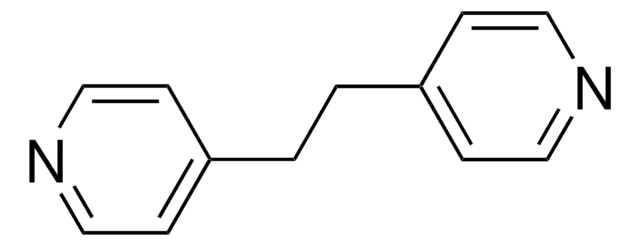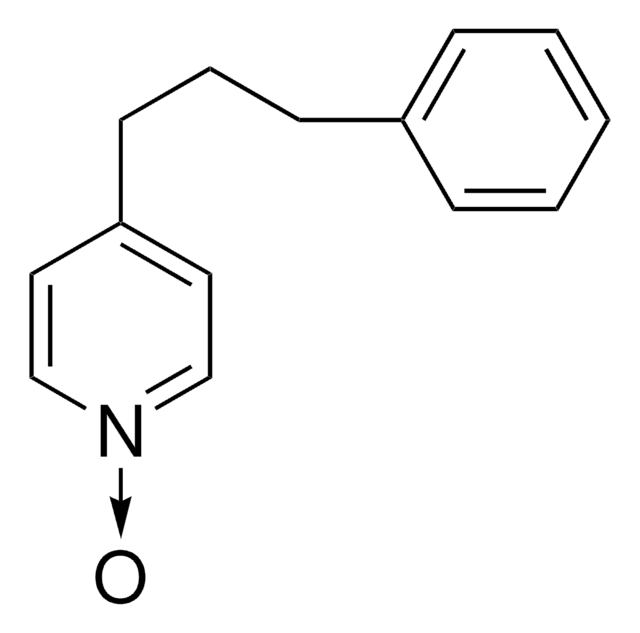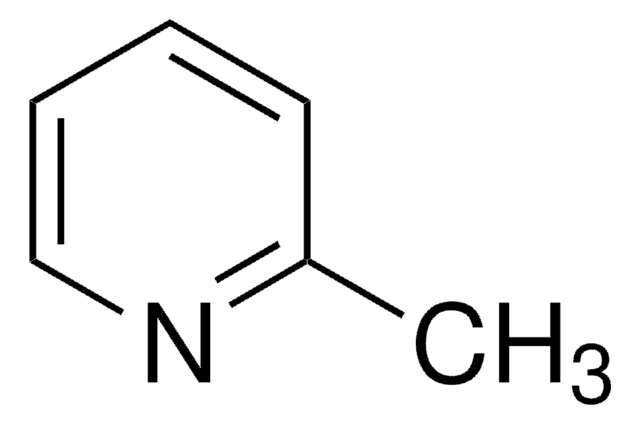All Photos(1)
About This Item
Empirical Formula (Hill Notation):
C14H15N
CAS Number:
Molecular Weight:
197.28
EC Number:
MDL number:
UNSPSC Code:
12352100
eCl@ss:
39151717
PubChem Substance ID:
NACRES:
NA.22
Recommended Products
Assay
97%
refractive index
n20/D 1.563 (lit.)
bp
322 °C (lit.)
solubility
H2O: insoluble
density
1.03 g/mL at 25 °C (lit.)
functional group
phenyl
SMILES string
C(Cc1ccccc1)Cc2ccncc2
InChI
1S/C14H15N/c1-2-5-13(6-3-1)7-4-8-14-9-11-15-12-10-14/h1-3,5-6,9-12H,4,7-8H2
InChI key
AQIIVEISJBBUCR-UHFFFAOYSA-N
Related Categories
General description
4-(3-Phenylpropyl) pyridine is an organic solvent and is a suitable medium for water insoluble transition metal complexes of porphyrins or phthalocyanines.
Application
4-(3-Phenylpropyl) pyridine(PPP) was used in electrochemical processes for a novel system of microdroplets of PPP immobilised at graphite and in mesoporous ceramic electrodes. PPP has been used to investigate electrochemically driven mono-, di-, and tri-carboxylate anion transfer at the 4-(3-phenylpropyl)pyridine/aqueous electrolyte interface for a triple phase boundary system at graphite electrodes.
Signal Word
Warning
Hazard Statements
Precautionary Statements
Hazard Classifications
Eye Irrit. 2 - Skin Irrit. 2 - STOT SE 3
Target Organs
Respiratory system
Storage Class Code
10 - Combustible liquids
WGK
WGK 3
Flash Point(F)
235.4 °F - closed cup
Flash Point(C)
113 °C - closed cup
Personal Protective Equipment
dust mask type N95 (US), Eyeshields, Gloves
Choose from one of the most recent versions:
Already Own This Product?
Find documentation for the products that you have recently purchased in the Document Library.
Stuart M MacDonald et al.
Physical chemistry chemical physics : PCCP, 10(26), 3925-3933 (2008-08-09)
Understanding liquid|liquid ion transfer processes is important in particular for naturally occurring species such as carboxylates. In this study electrochemically driven mono-, di-, and tri-carboxylate anion transfer at the 4-(3-phenylpropyl)pyridine|aqueous electrolyte interface is investigated experimentally for a triple phase boundary
Frank Marken et al.
Faraday discussions, 129, 219-229 (2005-02-18)
Biphasic electrode systems allow electrochemical reactions to be driven in a microphase of organic liquid (typically 1-100 nL), which is coupled via ion transfer processes to the surrounding aqueous electrolyte medium. Microdroplet deposits on basal plane pyrolytic graphite as well
Xueqiang Qi et al.
Dalton transactions (Cambridge, England : 2003), 43(24), 9283-9295 (2014-05-14)
Core-shell RuPt (Ru core-Pt shell) and PtRu (Pt core-Ru shell) nanoparticles were prepared by decomposing in a two-step procedure a ruthenium ([Ru(COD)(COT)] (COD = 1,5-cyclooctadiene, COT = 1,3,5-cyclooctatriene)) and a platinum complex ([Pt2(dba)3] (dba = dibenzylideneacetone) or [Pt(CH3)2(COD)]) in the
Our team of scientists has experience in all areas of research including Life Science, Material Science, Chemical Synthesis, Chromatography, Analytical and many others.
Contact Technical Service


![4-[6-(4-pyridinyl)hexyl]pyridine AldrichCPR](/deepweb/assets/sigmaaldrich/product/structures/969/304/69102a98-4497-4db9-b5d7-792b9c6fb5e7/640/69102a98-4497-4db9-b5d7-792b9c6fb5e7.png)






